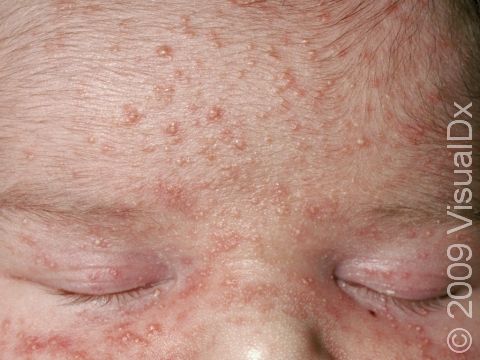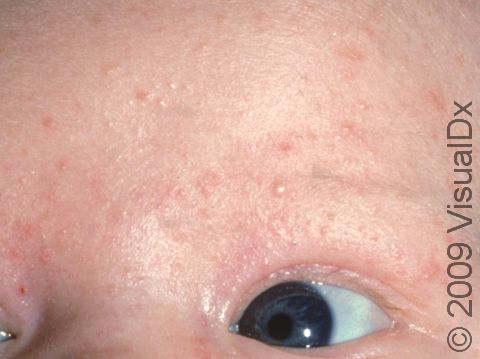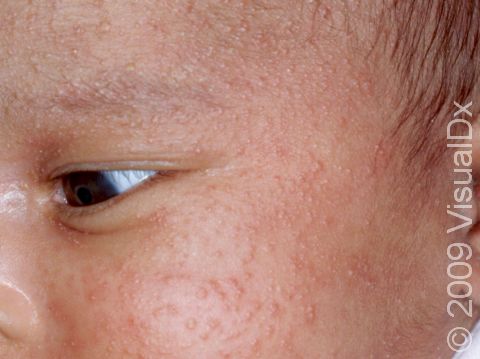Baby Acne (Neonatal Acne)
Babies can develop acne on their face that looks like acne commonly seen in teens. Although the cause of baby acne is unknown, it may be the result of maternal or infant hormones (androgens) stimulating glands in the face to produce oil, or sebum. Baby acne can essentially be divided into 2 groups: neonatal acne, which affects newborns in their first month of life, and infantile acne, which typically affects babies ages 3-16 months. Neonatal acne is typically mild, while infantile acne is usually more severe than neonatal acne and consists of more lesions. Neonatal acne usually resolves on its own within 3 months. Infantile acne may last a few weeks to a few months, and most cases usually resolve by age 3 years.
Who's At Risk?
Neonatal acne occurs in about 20% of newborns. Infantile acne appears to be less common. Males tend to be affected more often than females, but the reason is unknown.
Signs & Symptoms
Baby acne consists of multiple red papules (small, solid bumps) and pustules (pus-filled bumps), commonly found on the baby’s cheeks, chin, and forehead. Papules may appear brown in darker skin colors. Skin can have blackheads (open comedones) and whiteheads (closed comedones) present as well. Scarring of the affected areas can occur but is rare.
Self-Care Guidelines
Most instances of baby acne go away on their own and do not cause scarring.
In mild cases of baby acne, using a daily cleanser is usually the first step in treatment. Gentle, fragrance-free, nonsoap cleansers (Dove, Cetaphil, or Bioderma) are best and should be applied to the affected area and washed off with water every 24 hours. Newborns and infants have very sensitive skin, so scrubbing should be avoided. Also avoid using oils or lotions on the face, as they may make the acne worse.
Treatments
In mild cases of baby acne, prescription therapy is generally unnecessary, and the lesions may resolve with gentle cleansing of the skin.
In moderate cases, the medical professional may prescribe benzoyl peroxide, clindamycin, erythromycin, or tretinoin cream. In some cases, a topical antifungal may be prescribed.
The medical professional may request the help of a pediatric dermatologist for severe cases of baby acne or those resistant to therapy, and an investigation for an underlying hormonal (endocrine) disorder may be warranted.
Visit Urgency
Baby acne is generally harmless and does not require medical care, but if you have any questions or feel that the acne on your baby’s skin is worsening despite using daily cleansing with a gentle cleanser, it is best to seek medical care. Additionally, if your baby is prone to scratching or picking at these lesions, there is a risk the affected areas could develop a bacterial skin infection, and it is best to seek medical care.
Trusted Links
References
Bolognia J, Schaffer JV, Cerroni L. Dermatology. 4th ed. Philadelphia, PA: Elsevier; 2018.
James WD, Elston D, Treat JR, Rosenbach MA. Andrew’s Diseases of the Skin. 13th ed. Philadelphia, PA: Elsevier; 2019.
Kang S, Amagai M, Bruckner AL, et al. Fitzpatrick’s Dermatology. 9th ed. New York, NY: McGraw-Hill Education; 2019.
Paller A, Mancini A. Paller and Mancini: Hurwitz Clinical Pediatric Dermatology. 6th ed. St. Louis, MO: Elsevier; 2022.
Last modified on June 26th, 2024 at 12:51 pm

Not sure what to look for?
Try our new Rash and Skin Condition Finder


